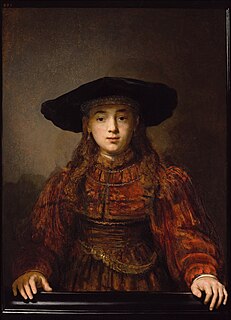 W
WThe Constitution of 3 May 1791 is an 1891 Romantic oil painting on canvas by the Polish artist Jan Matejko. It is a large piece, and one of Matejko's best known. It memorializes the Polish Constitution of 3 May 1791, a milestone in the history of the Polish–Lithuanian Commonwealth and a high point of the Polish Enlightenment.
 W
WThe Election of Stanisław August is a 1778 oil on canvas painting by Bernardo Bellotto, produced to the instructions of its subject Stanisław August Poniatowski and now hanging alongside twenty-two other paintings by the artist in the Senatorial Hall of the Royal Castle, Warsaw, also known as the Canaletto Hall. A first version produced in 1776 had not met with Stanisław August's approval and instead was given to Crown Marshal Franciszek Rzewuski; it is now in the National Museum, Poznań. Both works show the 1764 Polish–Lithuanian royal election, the last free royal election in the Polish–Lithuanian Commonwealth.
 W
WThe Girl in a Picture Frame is a 1641 oil on panel painting by the Dutch artist Rembrandt. It is also known as The Jewish Bride and The Girl in a Hat. With The Scholar at the Lectern and Landscape with the Good Samaritan, it is one of three Rembrandt paintings in Polish collections. It is currently located at the Royal Castle in Warsaw.
 W
WHistory of Civilization in Poland is a cycle of twelve oil sketches on canvas and wood, created by the Polish nominal painter Jan Matejko in 1889 with accompanying commentaries. The originals are kept at the Museum of the Royal Castle, Warsaw.
 W
WMiodowa Street is a 1777 oil on canvas painting by Bernardo Bellotto, then court painter to Stanisław August Poniatowski, king of Poland. Now in the Royal Castle, Warsaw, it is one of a series of twenty-two images of Warsaw by this artist and shows the junction of Miodowa Street with Senatorska Street. On the left is the Krakow Episcopal Palace and the now-lost 1774 Tepper Palace designed by Ephraim Schröger. On the right is the Branicki Palace and Krasiński Palace
 W
WPrince Michał Jerzy Poniatowski was a Polish nobleman.
 W
WRejtan, or the Fall of Poland is an oil painting by the Polish artist Jan Matejko, finished in 1866, depicting the protest of Tadeusz Rejtan against the First Partition of Poland during the Partition Sejm of 1773. Both a depiction of a historical moment, and an allegory for the surrounding period of Polish history, the painting is one of Matejko's most famous works, and an iconic picture of an emotional protest.
 W
WThe Scholar at the Lectern or The Father of the Jewish Bride is a 1641 oil on panel painting by the Dutch artist Rembrandt. With The Girl in a Picture Frame and Landscape with the Good Samaritan, it is one of only three Rembrandt paintings in Polish collections. It is currently located at the Royal Castle in Warsaw.
 W
WStephen Báthory at Pskov or Báthory at Pskov is a partially allegorical historical painting 1872 by the Polish artist Jan Matejko, now in the collections of the Royal Castle in Warsaw, Poland. It shows people of the Russian tsar Ivan the Terrible kneeling before the Polish king Stephen Báthory at Pskov during the final period of peace negotiations at the end of the 1578-1582 Livonian campaign. It also shows the papal legate, the black-robed Jesuit Antonio Possevino.